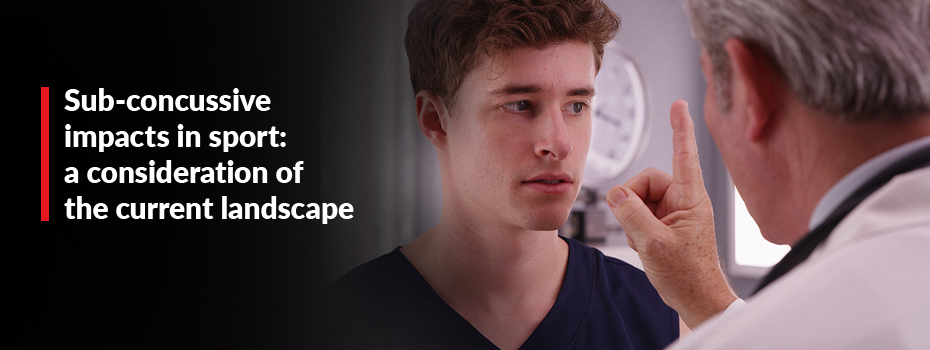
Sub-concussive impacts in sport: a consideration of the current landscape
09 August 2023 11:30
Leon Harris and Simone Pearce UNIVERSITY of the SUNSHINE COAST
There is clear evidence that contact sports such as Australian Rules Football can lead to serious brain injury, leaving players with life-changing, and potentially catastrophic consequences. Most recently, we have seen class action proceedings instituted against the Australian Football League, as well as individual court actions such as that by former Australian Football League Women Collingwood vice-captain Emma Grant, as well as another by Gary Ablett Sr.
The AFL currently focus exclusively on concussion. There is no evidence that they are dealing with the serious issue of repeated sub-concussive impacts on the brain. There are other distinctive issues around concussion and sub-concussion, such as the increased risk to women and children.
Additionally, in dealing with the legal consequences of concussion and sub-concussion, there are different duties of care depending on the amateur or professional status. Despite the legal and media attention to concussion and its consequences, there are many issues being neglected. New judicial guidance is needed to clarify the way sporting organisations deal with risks that are inherent in the game but not necessarily known to the public or acknowledged by the sport.
This article comes from the experts behind the Sports Law Bulletin which covers the latest Australian and international developments and current thinking on sports law issues. It provides commentary on a broad range of topics including sports governance, anti-doping, commercial aspects of sport, athlete’s rights and protections, integrity and disciplinary proceedings, human rights and discrimination, and diversity and inclusion in sport.
Subscribers to the Sports Law Bulletin can read the full article HERE.
In 2020, an outstanding young sportswoman, Jacinda Barclay, died after a short and tragic battle with mental illness. Apart from being an elite AFLW footballer who played for 4 years with the GWS Giants, she had another more tragic distinguishing feature. She was the first female contact sport participant diagnosed in Australia with signs of brain degradation by the Australian Sports Brain Bank.
What makes her case more troubling is the changes in Barclay’s brain did not result from any other identifiable conditions that might explain them, like diabetes, strokes or heart disease for example. Barclay had also represented Australia in baseball and played American football as a “quarterback in the short-lived LFL Australia, and later in the United States” and was a very physically fit and capable young woman.
Except for her brain.
It showed marked degradation in cerebral white matter which has been linked to repetitive head injury from contact sports. What makes her case even more concerning is something the major football codes in Australia, and in this case the AFL, have been very reluctant to publicly acknowledge.
Barclay did not have a substantial clinical history of concussion. Her brain showed no evidence in her having sustained a concussion in the weeks before she died.
In other words, simply playing a contact sport, tackling, and being tackled repeatedly over her career, may have been enough to cause degradation in her brain to the extent her mental capacity was seriously affected. White matter changes and repeated head injury have been linked with mental illness and suicidal ideation. Tragically, a number of other former star players of contact sports in Australia such as Paul Green (rugby league), Shane Tuck and Danny Frawley (AFL) among others have also taken their own lives in recent years. They were all suffering from CTE (Chronic Traumatic Encephalopathy), a neurodegenerative brain disease linked to repeated head trauma which is primarily found in contact sport participants. It has been the subject of much recent commentary and detailed scholarly discussion. Others such as Mario Fenech (rugby league) and Michael Lipman (rugby union) have also come forward to detail their own battle with early-onset dementia, which has again been linked to the playing of contact sports where severe or repeated head impacts occur.
The link between repeated head trauma and neurodegenerative brain disease is clear and can have tragic consequences for those affected. However, the sporting codes in Australia appear to be focussing solely on concussion and its effects. Barclay did not have a substantial history of concussion, but she did have damage to her brain. The focus on “concussion” would not have helped her avoid injury as she apparently had no significant history in that regard. It would seem the sporting codes, while focussing on fixing one issue, seem to be avoiding dealing with another, potentially more widespread and serious problem.
Focus on concussion may be missing the bigger problem
The AFL focus almost entirely on concussion. Concussion itself is defined in this sporting context as “as a traumatic brain injury induced by biomechanical forces”. This means people are rendered unconscious or clearly demonstrating signs of brain injury after a serious collision such as loss of motor control, jerky movements of the hands, arms, legs and torso and confusion. This is referred to as concussion ataxia.
The measures currently in place deal with concussion almost exclusively. That is perhaps not surprising, given the significant literature about the risks of concussion, links to CTE and other conditions, and the various legal actions now being brought by footballers in various codes.
What does not appear to have been adequately considered, are cases where there may only be repeated sub-concussive impacts. These type of impacts on the brain are not individually enough to cause concussion evidenced by the actual loss of consciousness or obvious immediate impacts such as concussion ataxia. These sub-concussive impacts may go unnoticed or undetected and occur during the usual course of the game or training through contact such as tackling and being tackled. Such impacts are of sufficient force to cause the brain to move around inside the skull, impacting against the cranial wall, but not of enough force in isolation to cause unconsciousness or concussion ataxia. A single sub-concussive impact is unlikely by itself to result in long-term damage. The harm arises when there is an accumulation of such impacts over a period of time.
Not just CTE
The medical evidence is clear that sub-concussive impacts do cause brain degradation as well as other serious conditions such as CTE (Chronic Traumatic Encephalopathy). Additionally, other neurodegenerative diseases such as Alzheimer’s disease, amyotrophic lateral sclerosis, also known as Lou Gehrig’s disease, Parkinson’s disease or frontotemporal lobar degeneration have also been diagnosed in contact sport participants at rates far above those who have not participated in such sports. Evidence indicates contact sport participants are around four times more likely to die from some form of neurodegenerative disease. However, being “knocked out” is not the only, or even the main risk factor, and the focus on that is obscuring other serious legal, medical and social concerns. Those who may never have suffered an injury that has rendered them unconscious or demonstrated symptoms of concussive episodes, are still doing damage to their brain.
The evidence shows that women and children may be more vulnerable to brain injury from contact sport generally. The risk of damage to the brain is increased for women and children. Currently, it is estimated that nearly 600,000 women and girls participate in the game of AFL in Australia. There is clear medical evidence that women and children are at increased risk of brain injury from sub-concussive as well as concussive impacts occurring in contact sport due to physiological difference from adult males. The question posed here is what then are the legal ramifications for sporting bodies? This issue has not been litigated, nor is there literature exploring the ramifications. There is limited information and no clarity around the risks and mitigation measures necessary to reduce the risk. More importantly, there appears to be little attention and concern to the issue.
The AFL’s approach
In the case of professional female players in the AFLW, it could be argued the duty of care is clearly established for the AFL in relation to liability for injury to the AFLW players, that of an employer to ensure a safe work environment for employees. From a legal perspective, should information come to the attention of an employer about the risks of injury employees may suffer as a result of carrying out their work duties (in this case playing Australian rules football in the AFLW), there would seem to be a duty to provide all relevant information that such risks exists. It would also follow that, where appropriate, mitigation measures should be instituted to minimise such risk. This does not seem to be the case based on public statements and guidelines currently available in the AFL. Of course, when there is not an employment relationship, the duty, risk and potential liability is different.
At present, both for professional and amateur players, the focus is entirely on what should occur when concussion happens, as opposed to the dangers of repetitive sub-concussive impacts. The futility, inadequacies and ineffectiveness of concentrating on managing concussion to prevent brain injury aside, there is a significant gap in the attention paid to effects of head knocks that do not result in concussion. The AFL published “Management of Sport-related Concussion in Australian Football”. A search through the document shows the word “concussion” is mentioned around 100 times. The words “sub-concussive” (or variations on that) is not mentioned at all. Neither are the words “repeated”, “repetitive”, “CTE” or any of the other neurodegenerative diseases that stem from repetitive impacts to the brain. Given the increased medical science and media interest in brain injuries resulting from contact sport, the lack of information around risk to participants other than those “concussed” seems problematic.
Agar v Hyde — time for a rethink?
Whether or not a sporting body is responsible, at law, for an injury such as brain injury from sub-concussive impacts is further complicated when it comes to amateur participants in general and children in particular.
The decision of Agar v Hyde could prima facie be seen as providing a barrier for anyone seeking to take the AFL to (legal) task for brain injury suffered from playing the game, even if never knocked out. This decision by the High Court held there was no duty of care owed by a governing body of amateur sport participants to ensure that the outcome of the rules of the sport did not place players at risk of injury. This case was about the World Rugby Board (as it is now known) and its obligation to compensate players, following spinal injuries suffered by two amateur players in scrum collapses. This decision was based on a number of factors, including; the scope of liability to multiple indeterminate number of participants; that participants must take some responsibility and had consented; the lack of governing body control at the club and game level; and public policy.
However, the numerous measures sports organisations have taken to mitigate the effects of concussive injury, based on medical research around contact sports and repetitive head impacts, indicate a tacit acknowledgment that such a duty does exist and that the decision in Agar v Hyde would no longer be persuasive, or could be distinguished. The decision in Agar v Hyde might now be distinguished or departed from, if there were a current case asking a court to consider whether a governing body should be liable for injuries suffered by a participant arising from such a risk. It is suggested that:
… where the risk is one known or understood only by a few because it is in the realm of emerging medical knowledge, it is undesirable for the sport governing body that has access to that knowledge to have no legal obligation to even consider rule changes as a protective measure.
There is an additional perspective that the courts have not considered to date, and that is failing to warn of the dangers of the sport known to them, and not evident to participants, but accepted by medical research. It might also be difficult to claim a participant voluntarily assumed the risk of injury when such information is not readily available to the public, and not disclosed by the sporting organisation responsible. The issue of voluntary assumption of risk is important and contentious. In the context of an absence of information of risk, the examination of the law and effect of exclusions from liability for a voluntary assumption of risk have not been considered.
In Queensland, the Civil Liability Act 2003 (Qld) (“the CLA”) particularly s 19(1) is important. It states that:
A person is not liable in negligence for harm suffered by another person as a result of the materialisation of an obvious risk of a dangerous recreational activity engaged in by the person suffering harm.
The way in which “obvious risk” is defined would be significant. In the act, an obvious risk is defined as “a risk that, in the circumstances, would have been obvious to a reasonable person in the position of that person.
Section 13(2) outlines “obvious risks include risks that are patent or a matter of common knowledge”. Similar sections exist in other Australian jurisdictions.
It may be arguable that while the risk of associated with concussion are matters of “common knowledge” to the reasonable person, the risks associated with sub-concussive impacts are not. However, these risks are in fact known, or should be known, given the state of the medical literature and media coverage of the issue, to the governing bodies of contact sports such as the AFL.
Section 11 of the CLA is also relevant. This provides that for a breach of duty to have caused a particular harm, the breach can be identified and proven to have caused the harm, and it is appropriate for the person with the duty to be held responsible for it. Any contribution to the harm, in limited circumstances can be treated as a cause of the total harm suffered, provided it made a “material contribution” to the harm. Therefore, a failure, that constitutes the alleged negligence, need only have made a material contribution to the CTE or other disease. It has been argued recently that the appropriate criteria that should be applied to proving causation in relation to CTE and contact sport participation should be the medical causation criteria called the Bradford Hill criteria. When this is applied, the link between contact sports and CTE and/or other neurodegenerative diseases, is clearly established.
Issues of informed consent by minors
Even if there was a warning of the dangers of sub-concussive impacts, questions also arise about the ability of children to understand and then in fact consent to such risk. If such risks exist, the ability of a child to consent to those risks, or indeed have their parent/caregiver do so on their behalf raises an entirely new set of difficult legal questions. The answers to these questions in relation to contact sport participation have not yet been the subject of consideration by the Australian courts.
Mitigation measures related to concussion risks, proposed and in fact now occurring in some overseas jurisdictions and by medical experts in the field in Australia, suggest contact sport for those under the age of 14 should be significantly limited, if not entirely banned. Other measures include restrictions enforced on contact in training and monitoring of cumulative head impacts through the use of technology such as micro-chipped mouth guards with a view to player “stand-downs” when thresholds are reached. These measures are admirable but there are difficulties with equitable access to such technology and proper monitoring processes to ensure adherence to contact protocols, especially at the amateur junior level, are problematic.
Concluding remarks
Brain injuries suffered by those who play contact sport can have serious and lasting consequences for, not just the participants, but their families and wider society in general. With AFL numbers approaching 600,000 for women and girls, and with children under the age of 14 numbering somewhere near 400,000 in Australia alone, the potential legal liability through weight of numbers alone is startling. Estimates vary on how many participants in contact sports may be affected. One actuarial study even put the figure of former NFL players who may develop some form of neurodegenerative disease as high as 28%. It also seems the earlier a person starts such a sport and the longer they play, the likelihood of being affected at some point increases. The danger posed by repeated sub-concussive impacts over time needs to be much more clearly enunciated to all participants so that, at the least, informed consent to such risk is possible. Until clearer disclosure of the inherent risk to the effects of sub-concussive impacts incurred in playing the sport is made at all levels, and more appropriate mitigation or protection measures mandated and actually enforced, possible future plaintiffs may find fertile ground for legal claims.
Latest Articles
-
 Gayann Walkers is a well-respected Victorian Barrister. Tis interview focuses on what it takes to be a Barrister in sports law, and what the future of the field looks like.
Gayann Walkers is a well-respected Victorian Barrister. Tis interview focuses on what it takes to be a Barrister in sports law, and what the future of the field looks like. -
 The growth of artificial intelligence technologies in Australia has recently come under the spotlight, as the Albanese Government looks to review existing regulatory and governance mechanisms and establish applicable safeguards that are fit for purpose in the current day and age.
The growth of artificial intelligence technologies in Australia has recently come under the spotlight, as the Albanese Government looks to review existing regulatory and governance mechanisms and establish applicable safeguards that are fit for purpose in the current day and age. -
 Artificial Intelligence (AI) is developing fast – but how should it be used? Over the past month, the ethical use and development of AI have been heavily scrutinised as policymakers, intellectuals, and industry leaders debate whether a moratorium should be imposed on AI’s development, or whether AI should be embraced in the name of economic growth.
Artificial Intelligence (AI) is developing fast – but how should it be used? Over the past month, the ethical use and development of AI have been heavily scrutinised as policymakers, intellectuals, and industry leaders debate whether a moratorium should be imposed on AI’s development, or whether AI should be embraced in the name of economic growth.
Practical Guidance
Your one-stop solution for accurate legal answers from Australian legal experts. Tools, practically focused guidance notes, checklists, precedents, and training materials support and streamline your legal workflow.
LEARN MORE LexisNexis
LexisNexis